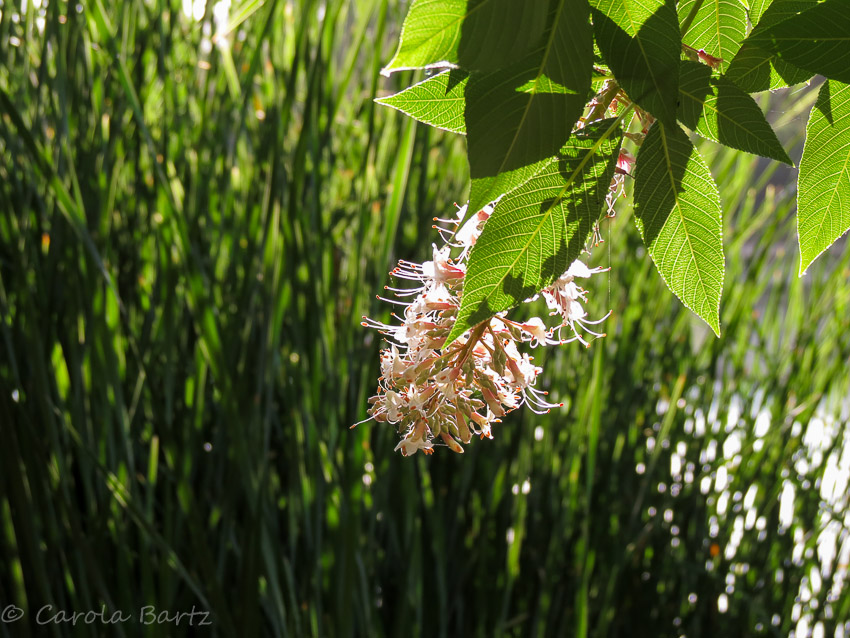The Northern California climate doesn't allow horse chestnuts to thrive here. But we have a different tree that is related to it.
The California buckeye (Aesculus californica) is native to California and southwestern Oregon. Compared to its European relative it is rather short and almost has an umbrella shape. The flower spikes that appear in the spring after the leaves have emerged are white (with just a hint of light pink) with bright orange pollen. The entire tree is covered with these flowers and is quite a sight!
After the flowers are gone and we get into summer the tree does something remarkable: in order to survive the drought of the long summer months it drops all of its leaves and waits for the winter rain. However, the tree will develop its fruit in late summer that ripens in fall. It is sitting in a leathery capsule that hangs from the bare branches.
Slowly, those capsules will split open. I have read somewhere that this is the reason it was named "buckeye".
And then - in November the buckeyes will fall to the ground, either still sitting in the capsule...
... or popping right out of them. Their color is lighter than their European relatives, with reddish hues. It's a beautiful warm and earthy color, fitting for autumn.
The tree is poisonous in all its parts including the nuts. Some animals eat them if they don't find anything else, but usually they go unnoticed and just make new buckeye trees.
There are several buckeye trees at the lake and every autumn I check when the buckeyes will drop. This year they started to fall just last week. I gathered up three of them to bring home and use for decoration; the rest I left where they dropped. However, whenever I am at the lake I take a short detour to check how many more have fallen.











10 comments:
How absolutely fascinating. I had heard of buckeyes but didn't realise that they drop all their leaves and wait for rain. What an incredible adaptation.
And love that vibrant colour.
Many thanks.
They really are beautiful. I can imagine using them for craft projects. I didn't know they were poisonous but oh, they are so rich in color! Happy Thanksgiving, Carola.
What an interesting story about the buckeye trees. That's too bad they're poisonous. The nuts almost look good to eat. I haven't seen them around my neck of the woods. Their flowery pink buds must look pretty in Spring. So now, since it's November, it's probably time for the buckeyes to fall to the ground. So interesting, and thanks for sharing a bit about this tree.
I hope you have a nice Thanksgiving, Carola, with lots of good foods to eat. ; )
~Sheri
What a wonderful and quite beautiful tree, one I am completely unfamiliar with. I wonder if they are in commercially available.
Here in Kentucky, our native Chestnut trees suffered from a blight, many years ago. Lovely to see yours.
They do look very similar to the conkers we get here in the UK …
Your photographs are amazing and thank you for the information about Buckeye trees - an interesting read.
All the best Jan
Thanks for sharing, beautiful tree and the buckeyes are amazing!
Wishing your family a wonderful Thanksgiving!
cool buckeye photos. I have heard of that tree, but didn't know what they looked like.
I don’t think I’ve ever seen a buckeye tree. These are fascinating!
Thanks for telling us about this fascinating tree, the buck eyes look beautiful. In Wisconsin I gathered what we called chestnuts from our neighbor's huge tree, each chestnut was a work of art and shone like it was waxed.
Post a Comment